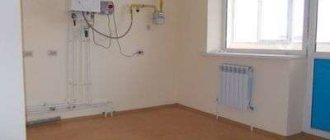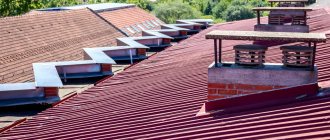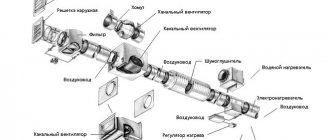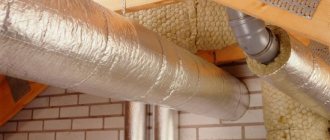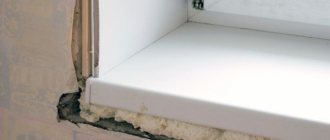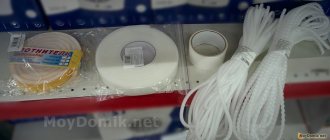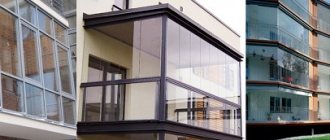Replacing wooden frames with plastic ones significantly increases the comfort of the room. Heat loss in winter is reduced, street noise and dust also do not penetrate through the sealed glass unit. When replacing a wooden ventilated window with a modern version, there is one significant “but” - the room is deprived of the flow of fresh air.
Ventilation of plastic windows does not matter for new houses, since the supply and exhaust system there does not work through the window frames. In old buildings, plastic windows have to be adapted to additional air intake from the street.
How to ventilate a room without a window
If standard ventilation is needed, then a system of air ducts, one for supply, the other for exhaust, with mechanical motivation.
Install the ventilation equipment in any convenient place, no matter in the ventilated room or in an adjacent one. But the main condition for the effective operation of such a system will be its calculation performed by a specialist
Contact an organization that specializes in ventilation systems. If “just so that it doesn’t feel stuffy,” then you can accept the option “Kolhozzing rules”:
Without taking into account the ventilation system of the room from which you recommend taking air, it is generally unclear how this entire structure will work and whether it will work at all. Don’t forget about the noise from the fan, possible vibrations in the ventilation ducts...
And the first step to the right decision is to contact specialists. Before you begin arranging ventilation in a room without windows, you need to find out the level of draft. Multi-storey buildings use a system of natural circulation of air masses, the operation of which is based on the laying of special channels.
You can arrange supply ventilation, which is arranged using a pair of fans, a filter, a heater, and a hammer drill
This design is designed to remove excess moisture from the room, but it is important to correctly calculate the diameter of the hole so that the system effectively copes with the assigned task
Types of ventilation devices
The flow of clean air into the apartment is ensured by ventilation mechanisms of different types, presented in a wide variety on the market.
Recuperator for apartment Marley
A device with an exhaust hood and an influx of heated air at the same time is in demand. It looks like a small box with two fans, a filtration system, a recuperator and a control unit. The mechanical device is hung on the wall and does not require energy.
There are mechanical and electrical devices based on their operating principle.
Hoods installed above kitchen stoves, fans, air purifiers with heat exchange in the bathroom, toilet, and other rooms can be turned on automatically along with electricity or by mechanically pressing a button.
Electrostatic ionizers imbue purified apartment air with positive health properties.
An example of an air purifier with a method of ventilating the interior space of a room through the passage of several filters.
- The primary pre-filter is made of foam or plastic mesh that is easy to wash and dry. Detains coarse dust, particles of pet hair, fluff, and hair. The better its quality, the longer the service of subsequent filters.
- Behind it are installed filters for smaller dust particles with bacteria and fungi, which, when breathed, enter the lungs and cause significant damage to human health, especially those with asthma and allergies. Nera filters capture the smallest dust particles and purify the air up to 99%. The more filters, the better the cleaning system.
- The last filtration is with activated carbon, in which volatile microparticles settle and are retained, and unpleasant odors go away along with them.
Instead of activated carbon, the air can be filtered by passing through water.
Mechanical devices do an excellent job of cleaning the microclimate inside an apartment; they are economical to use, but are expensive and require additional action to clean the primary filter, replace water, etc.
A properly selected method of ventilating an apartment with plastic windows should be silent, without temperature changes, with normal humidity, the air environment should maintain a cheerful mood and health.
Design Features
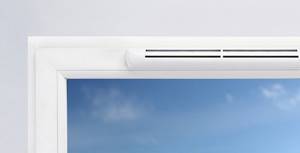
There are dozens of different models in stores, but they are all united by one design:
- Air intake. The product is located on the outside on a plastic frame. Designed to receive and transmit air flow from the street. Installation takes minimal effort and is completed in a few minutes.
- To prevent precipitation and dust from seeping into the room, a special canopy is installed on top.
- A telescopic channel is used to enter the air flow into the room. In appearance, this element resembles a special tube. It is mounted into the window body using milling and installed using a mounting sleeve.
- The incoming air passes through a special hole and enters the internal unit, which launches it into the room. This element consists of a nozzle, filter and regulator. Installation is carried out indoors.
Options for arranging forced ventilation of plastic windows
There are several options for solving the problem of air flow into a room with plastic windows:
- slot ventilation;
- self-ventilation device;
- window with discrete fixation or sash lock;
- supply valve.
Each of the proposed options for ventilation of plastic windows has its pros and cons. For example, a window makes the glass unit heavier and increases its cost.
Slit ventilation
Ventilation of plastic windows through micro-slits is provided for by the frame design. If you turn the handle of the tilt-and-turn sash 30-45 degrees from the vertical position, the window will not close completely. Air from the street will be effectively blown into the remaining gap.
This ventilation option does not require additional costs and is the most popular. Disadvantages include poor air flow in the warm season and constant draft in winter.
Self-ventilation
A self-ventilation device in a plastic window is provided at the stage of manufacturing the structure in the form of special holes in the frame. Air is taken from the street through holes in the profile located in the lower part of the frame; air enters the room through the holes in the upper part.
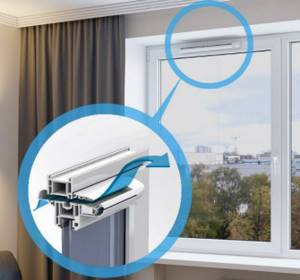
Passing between the doors, the cold flow has time to heat up and comfortable fresh air enters the room. Plastic windows with self-ventilation are more expensive than simple ones.
Window lock or discrete sash fixation
A window retainer (comb) is a special hook that secures a frame or window in a half-open position. The hook has several fixing grooves, which allows you to regulate the strength of the air flow. The device is inexpensive, simple and reliable. It can be independently installed on any plastic frame.
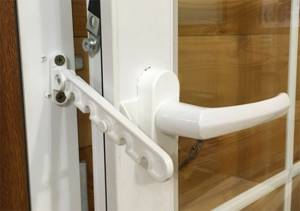
The discrete sash locking mechanism performs the same function as a window lock. The difference is that it is built into the frame and is not visible from the outside. Double-glazed windows with a discrete lock are more expensive than simple plastic window structures.
Supply valve
A supply ventilation valve for plastic windows is the most complex and expensive device for forced ventilation. Manufacturers offer supply valves with different capacities, different colors and different prices. The supply valve can be installed on a plastic window, either during its manufacture or on an already installed double-glazed window. The valve should be selected based on the area of the room.
Inlet valves operate automatically or manually. Automatic valves are activated when humidity and air temperature increase.
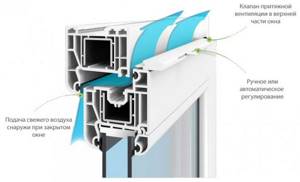
If you need to install a supply valve in the kitchen, then the best option would be to use a mechanical device. It can be used periodically, in manual mode, when intensive ventilation of the kitchen is needed. The rest of the time, air flow from the rooms will be sufficient for the kitchen.
Which valve to choose?
To choose the optimal ventilator model for installation on plastic windows, you need to decide on the method of its installation and the type of adjustment. The quality of the device largely depends on the manufacturer, and the efficiency of the device depends on the technical characteristics of the device.
Image gallery
Photo from
Cost as an argument in choosing an inlet
Window shape and installation location
Installation features and complexity of work
Efficiency and adjustment
Types of ventilators by design type
Supply valves for PVC windows are divided into three main groups according to their design features:
- folded;
- slotted;
- invoices.
Seam models
Micro-ventilation of the room in this case is carried out through a slot in the frame. The window can be equipped with such a device without dismantling the glass unit.
Advantages of rebated valves:
- affordable price;
- maintaining the heat and sound insulation qualities of the window;
- simplicity and speed of installation;
- possibility of automation.
Disadvantage: low throughput (up to 5 cubic meters/hour). To increase air flow, experts recommend installing two valves on one window.

Seam “supplies” are often equipped with humidity sensors. Preference should be given to models where the sensor-drive is remote from the ventilation duct - this guarantees accurate operation of the valve
Slot climate devices
Fresh air enters here through a gap whose width is 17-40 cm and height is 12-16 mm. The valve has an inlet and a control block. Improved models consist of one universal box.
Advantages of slot models:
- sufficient throughput (about 20 cubic meters/h);
- protection from external factors;
- Possibility of installation without removing the glass unit.
The disadvantage is the difficulty of installing two-block models that require milling of the window block. Cheaper analogues do not have this disadvantage. Simple “intakes” provide air flow through the space between the sash and the frame.

To install a simple ventilator, it is enough to remove part of the standard seal on the frame and place the valve according to the manufacturer’s instructions
Overhead valve models
Such valves are similar in principle to slotted models. The main advantage of the device is its high productivity (up to 100 cubic meters per hour). “Intakes” are located in both fixed and openable windows. However, the installation is carried out before installing the double-glazed window.
Surface-mounted devices are usually used in industrial and office premises; installation in a house or apartment is impractical. In addition, such valves allow street noise to pass through and reduce the thermal insulation of the window.
Ways to control a window “inlet”
Depending on the design of the valve for plastic windows, the intensity of the supply ventilation can be constant or adjustable. Optimal microclimate parameters can be achieved using a ventilator with control options, which can be automatic or manual.
The operation of an automatic valve is based on one of the principles:
- Stabilization of air supply due to the pressure difference between the room and the street . The owner sets the permissible range of air flow, which is supported by the device under various atmospheric conditions.
- Adjustment of air circulation using a polyamide sensor . The flow area of the valve increases with excess humidity, and when optimal microclimate indicators are reached, it decreases.
The disadvantage of automatic devices is their high cost. In addition, in some models it is impossible to completely block ventilation.
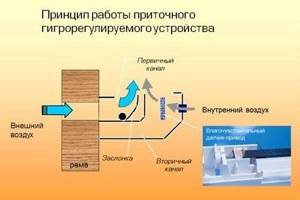
The operation of a hygro-controlled drive is based on the principle of a physical law: when humidity decreases, matter narrows, and when humidity increases, it lengthens
The air flow in a mechanical device is adjusted by changing the position of the valve or curtain.
The manual setting method allows you to independently choose the time to ventilate the room. This method is more crude - unconsciously, a person on his own can allow drafts to arise and the room to become overcooled.
Selection of main valve characteristics
When choosing a ventilation valve, special attention should be paid to the following parameters:
#1 – Performance Range
The value of the indicator depends on the pressure difference at the outlet and inlet, as well as on the flow area of the “inlet”. When evaluating models, it must be taken into account that in the technical characteristics, the throughput is always indicated in relation to the pressure difference.
It is not at all necessary that a device with a capacity of 15 cubic meters. m/h at 10 Pa will allow a greater air flow to pass than an analogue with an indicator of 12 cubic m/h at 5 Pa.

Normal air exchange in the room is ensured by valves with a capacity of 20-35 cubic meters per hour at a static pressure of 10 Pa
No. 2 – Providing sound insulation
Most metal-plastic windows have a sound insulation value of 30-35 dB. The supply unit must meet such characteristics that after installing the valve, the noise level in the room remains the same.
No. 3 – Operating temperature
Water vapor escapes through the ventilation device. In winter, this is fraught with complete icing and equipment failure.
Modern systems use the principle of “thermal break” - a plastic insert is placed between the metal inner and outer parts.
No. 4 – Possibility of adjustment
For residential premises, it is undesirable to choose devices without the ability to control air exchange. There is always a need to change the intensity or completely block the ventilation duct.
It should be remembered that the window air intake is only an addition to the ventilation system of the apartment. If it does not work, it is necessary to restore the functionality of the air ducts. We recommend reading about how restoration measures are carried out in our proposed article.
Review of popular ventilator models
There are quite a few models of ventilation valves on the market from different manufacturers. Like every industry, there are leaders here: Aereco, Air-Box, Helios, Vents and Siegenia .

Aereco valves of the EHA2 series, as well as products from the manufacturer Helios with the letter designation “S” are distinguished by increased sound insulation (+)
Aereco (France) offers various modifications of ventilators. Automatic valves are equipped with a V8 sensor and operate on the principle of hygroregulation. The actuator sensor is located away from the air flow.
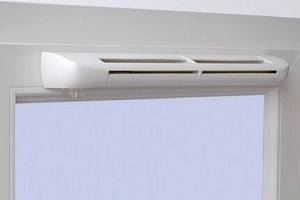
Aereco ventilation valves for arranging plastic windows are available in several colors: white, teak, beech and gray. Canopies can be purchased separately for better acoustic protection
Popular Aereco :
- ENA2 – available in three variations with different performance. The material of manufacture is plastic, the maximum capacity of the model range is 35 cubic meters. m./h., sound insulation – 37 dB.
- EMM - the main difference from previous products is the movable outdoor unit.
- EMF – lack of a hygroregulation system. The model is equipped with a manual mode switch.
Air-Box (Russia) produces plastic “supplies” for manual regulation. The main advantage of the models is ease of installation; the disadvantage is the lack of automatic control of humidity levels.
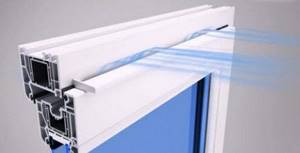
Air-Box valves do not come standard with any outdoor units. The narrow plastic case is installed only from the inside of the room on the frame sash
Air-Box Series :
- Standard – the valve is mounted without milling. The main purpose of the valve is to prevent condensation on PVC windows. The volume of incoming air is 4.8 cubic meters per hour with a pressure drop of 10 Pa, sound insulation is 32 dB.
- Comfort – two installation methods are possible. Inserting the ventilator into the frame increases its productivity from 31 to 42 cubic meters per hour. The inlet can be used in any rotary and tilt-and-turn structures.
- Comfort S – mounted only on milled holes. A special feature of the model is the two-way direction of air flow, which provides better ventilation of the room. Valve capacity is 40-42 cubic meters/hour.
Renson (Belgium) produces slot-type supply ventilation Aerovent . The valve is equipped with a filter and mosquito net. Manual control is provided using a cord - operation is carried out in two modes: “closed” and “open up”.

Main characteristics of Renson Aerovent: body material – aluminum, air flow – 21 cubic m/h at 10 Pa, sound insulation – 33-42 dB
How to install it yourself?
As already mentioned, supply valves (diffusers), which you can install yourself, will help ensure good ventilation in PVC windows. They are mounted on the frame and sash of the window and do not in any way affect the attractiveness of the window and the interior as a whole.
You can install diffusers yourself without involving outside experts. You don't need to have any special skills. By following the tips below, the entire process can be completed in 50-60 minutes.
To install the ventilation valve you will need:
- the valve itself (35 cm long);
- stationery knife;
- screwdriver or screwdriver;
- ruler or template.
All required parts for installing the diffuser must come with it:
- a piece of sealant 35 cm long;
- 2 seals, 16 cm each;
- three plugs for attaching the valve;
- self-tapping screws

We determine the location of the valve installation. The diffuser is placed on top of the window frame. Approximately in the center of the frame, use a ruler or a pre-prepared template to mark the place where the valve will be installed. Important: If the sash is narrow, you may have to move to the side so as not to get on the window fittings.
We remove the standard seal between the marks made
Using a knife, you need to carefully make cuts on the sides, after which the rubber product can be removed from the grooves without unnecessary difficulties.
Installing dowels for fastening In the holes where you pulled out the old seal, insert 3 fastening dowels (2 on the sides, 1 in the center). They will allow you to secure the valve to the frame.
At this stage we fix the valve itself
For convenience, it is recommended to apply double-sided tape (without protective film) to the product in advance.
We attach the valve to the frame using self-tapping screws. They should be screwed into previously installed dowels. After this, the valve will be considered securely fixed.
We install a new seal. Instead of the previous option, we place two 16 cm seals between the valve mounts (sold complete with the device).
We change the standard seal on the frame. This is necessary so that the air exchange in your home never stops. Mark a 35 cm section on the frame directly opposite the flap you just attached. We remove the seal that is there, and in its place we insert a substitute from the kit.
Example of installation of a ventilator with perforation
It is advisable to install the valve for perforation in the upper part of the window. The complexity of the work lies in the need to mill the frame - this cannot be done without special equipment and skills in working with power tools.
Carrying out preparatory work
When planning a valve insertion, you need to consider some points:
- It is better to install the ventilation device on a removed sash;
- installation is carried out in the warm season;
- When sawing a hole, you must work carefully so as not to damage the seal on the sash.
The sash is removed from its hinges and installed in an inclined or vertical position.
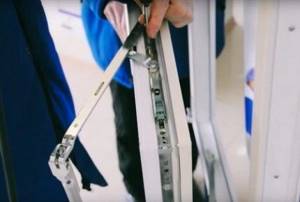
Part of the fittings (scissors and corner gear) are removed from the frame, and the counter strips are removed - they can interfere with milling
List of required tools
To install the inlet you will need:
- electric drill and drills (diameter – 5 mm and 10 mm);
- fine-grained file;
- jigsaw;
- template for marking holes;
- silicone sealant.
You can prepare a groove without a template, but it’s easier to work with. You can make a template yourself from plywood or hardboard.
Step-by-step installation and fastening
The entire process of installing a supply valve is divided into several stages:
Stage 1. Marking. Place a template on the vertical protrusion and mark the place where the device will be inserted.
Stage 2. Milling the sash. Using a large diameter drill, drill several holes in a row and connect them using a jigsaw. Repeat the operations on the frame fusion.
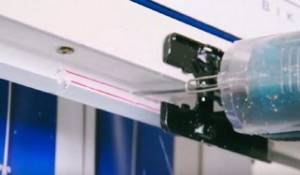
Window chambers opened during the milling process must be filled with sealant - this will prevent moisture from entering and whistling during air circulation.
Stage 3. Installation of the mounting strip and valve. Treat the back side of the plank with sealant, attach the part to the sash and secure with self-tapping screws.

Install the indoor unit of the ventilation device to the frame and snap the fasteners onto the bar. Check the evenness and strength of the valve location
Stage 4. Installation of the visor. Secure the protective visor on the outside of the frame with self-tapping screws. Treat the joint between the parts with sealant. It is advisable to use insurance during installation.
Stage 5. Completion of installation. Put the fittings back in place and hang the sash on the hinges. Set the ventilation device to the ventilation mode.
Micro-ventilation – always fresh air in the apartment
Is additional ventilation really necessary if residential premises are initially equipped with ventilation systems? The supply and exhaust circuit already guarantees constant air exchange, the norms of which can be found independently in the SNiP documentation.
Thanks to the natural impulse that underlies most ventilation systems, the air exchange rate is maintained. The multiplicity values are set out in SNiP 2.08.01-89*.
Diagram of air movement inside the apartment
Inlet valve matched to the frame texture
If in summer open shutters can compete with micro-ventilation devices, then at -15ºC it is unlikely that anyone will agree to open windows wide. Thus, special valves and devices provide fresh air flow, protect against condensation, do not create drafts, and do not require constant attention or maintenance. But you need to remember that for the normal operation of the supply units, proper exhaust ventilation is necessary.
What is taken into account during installation?
For efficient operation, not only the temperature difference, room features, etc., but also the correct installation are taken into account. Installation should only be carried out by a person who knows all aspects or is familiar with the basics. If the user has no experience in this area, then it is not recommended to assemble the product yourself, despite the ease of work. After all, to carry out this process, you must carefully follow the requirements and carry out each step in accordance with the instructions. For example, to install a slot valve you will need:
- Remove the small piece of seal that is present on the frame. A specific value is deleted; the entire upper seal cannot be removed unless required by the design of the device.
- A new sealing element is installed, which is several times thinner;
- Self-tapping screws are used to secure the equipment.
Professionals can perform installation in a different way. Pull out the old glass and install a new one, which will be smaller. In the place where the gap is formed, an inlet structure is installed. This method requires a lot of money, so it is used only when a person plans to completely replace the windows.
How to improve air circulation?
After checking, many decide to improve the efficiency of the system. This is easy to do by improving the flow of fresh air. Do-it-yourself ventilation in an apartment should begin again with a check. Take a piece of paper and place it near the channel opening, but at the same time the front door and windows must be tightly closed, and the interior doors must be completely open.
If the channels do not function sufficiently and the “test” paper falls, you need to check for a gap between the floor and the bottom of the doors. It should be 3-5 centimeters, because only in this case will ventilation in an apartment with plastic windows be optimal. If this option is not suitable, drilling several rows of holes 1-1.5 cm in diameter is allowed.
In a toilet, bathroom or bedroom, drilling holes can be done with an inclination towards the inside of the room. This approach eliminates the possibility of peeking into existing cracks. To improve sound insulation, a special mesh made of stainless steel or steel is installed. After completing the described steps, ventilation in the apartment improves.
How to choose a ventilation method
When choosing a ventilation system for an apartment with plastic windows, it is necessary to take into account a number of important factors.
The choice of the appropriate option is influenced by:
- room area;
- number of permanent residents of the residential premises;
- whether residents have certain diseases, such as asthma or allergies;
- state of the environment in the place of residence.
Based on these parameters, a system with the required performance and functionality is selected.
Fresh, clean air is especially necessary for young children, as well as for allergy sufferers and asthmatics.
Therefore, before you make ventilation yourself in a room protected from the street by plastic windows, you should take care of high-quality air filtration.
Exhaust ventilation system
Each apartment building has a stationary exhaust ventilation system, consisting of a central ventilation duct and air ducts connected to each apartment.
If you notice that you have a long-lasting smell after cooking, or “odors” from the bathroom and toilet rooms, this is evidence of insufficient or completely absent ventilation. Very often this phenomenon is observed after replacing conventional wooden frames with plastic double-glazed windows.
You can check the functioning of the built-in ventilation system in a simple way: just hold 5X15 cm strips of paper to the ventilation grille and monitor its condition:
- If the paper remains motionless, the ventilation system is not working. Open all the windows and hold the paper to the ventilation grill again.
- If the paper sticks to the grille when the windows are open, the channels are working and the problem is the supply of fresh air. This happens especially often in apartments with plastic windows, where natural ventilation from the outside is difficult.
- When, even with the windows open, the paper does not stick to the grille or barely moves, it is necessary to clean the air channels. Due to accumulated dust or dirt, debris, and insects, air movement through them is difficult.
Local ventilation ducts are installed in the kitchen and bathroom. Considering the particularly polluted and humid air, you can enhance the operation of the ventilation system here with the help of an exhaust fan.
Kitchens in the food preparation area must be equipped with a hood. Its use helps prevent the spread of kitchen odors and fumes throughout all living spaces.
To ensure ventilation in the bathroom, it is recommended to use an electric built-in fan. Given the high air humidity, it must have reliable protection from water. Fans of this level are marked IPx4. Exhaust fans are also required to operate quietly and have a production capacity of 50 or more m3 of air per hour.
Combining ventilation and windows
Anyone who cares about their own health is interested in the possibility of maintaining proper air exchange in an apartment with plastic windows.

Maintaining proper air exchange in an apartment with plastic windows is a necessity for those who care about their health
There are many options for upgrading natural duct ventilation in apartment buildings. Among the most effective methods are those that are installed on the double-glazed windows themselves or are already included with the window design from the factory.
Windows with a window
The ventilation system for PVC windows, for example from a company such as www.svetokna.ru, using a window leaf is the most common. The window provides a continuous supply of clean air. It mixes with exhaust room air, diffusion occurs, thanks to which the microclimate is normalized.
With natural ventilation, the appearance of drafts or the formation of condensation on the windows is excluded. The window can be fixed in several positions. But this design has a lot of disadvantages:
- Ventilation for plastic windows is installed at the design stage of the window opening. After installing the entire structure, it is impossible to improve ventilation.
- Such ventilation of plastic windows significantly increases the weight of the structure, which can negatively affect the house itself. Cracks may appear on the walls and window openings of a private house, so before calling a surveyor, it is better to consult with specialists from a construction company.
- Adding a window to the structure increases its cost.
- Increasing the plastic partitions in the window frame darkens the structure, and there is much less light in the room.
Plastic windows with self-ventilation
Plastic windows with ventilation using a self-ventilation system are the best option for both apartment buildings and private houses. Supply ventilation is installed on plastic windows and in industrial buildings, i.e. helps the operation of the main ventilation system.
Such ventilation in plastic windows consists of slot holes in the upper or lower part of the plastic window frame. Such slot ventilation allows clean air to continuously flow into the room through the openings. And thanks to the special arrangement of the holes in the frame, the cold air is heated and enters the room already heated.
Self-ventilation in windows has several negative aspects:
- This ventilation mode does not work in apartments on the upper floors or in private multi-story buildings. When installing ventilation after building a house, you need to carefully consider how to improve ventilation on the top floors without using this method.
- This ventilation system cannot be installed in already installed double-glazed windows, so you will have to completely change the entire window structure.
- High cost of windows with self-ventilation. Manufacturers increase the cost three or more times by complicating the production conditions for such structures.
This is why most people resort to specialized ventilation valves in the form of handles for plastic windows or combs.
Supply valve on a plastic window
Ventilation in a private house where plastic windows are installed is a necessary condition if the owner of the house cares about the health of his family members
What can be done in such cases?
No, you don’t need to replace good plastic windows with old wooden ones. In addition, no one suggests you open them wide during the cold season and let your apartment cool down.
Today there are windows with micro-ventilation that provide good air exchange. Such windows allow you to maintain a regular flow of fresh air into the apartment, thereby regulating temperature and humidity, will not create drafts, and will ensure the creation of a comfortable microclimate in your home.
Our task is to introduce you to each method in more detail so that you can independently choose the option that suits you best. Read about the consequences of poor ventilation and other ways to ventilate a room on the next page of our resource.
Supply valves
Supply (or ventilation) valves are divided into window and wall valves. Ventilation supply valves on plastic windows can be easily installed independently in 15 minutes; Installing a wall valve is a little more difficult because you have to make a hole in the wall.
These devices have many advantages:
- It is possible to regulate the air flow (manually or automatically).
- The windows stop fogging up.
- The valve is inexpensive - from 600 rubles.
- The device is quite easy to install and maintain.
Unfortunately, there are also a lot of disadvantages:
- Window ventilation valves are equipped with a maximum of one filter – coarse filter. That is, all harmful gases, particles and fine dust will remain in the room.
- The performance of the device is not very high. The fresh air entering through the valve is usually only enough for one person.
- In winter, the valves on the windows for ventilation often freeze and stop working.
By the way, there is also a valve handle
. This window ventilator is installed in the window profile instead of a conventional handle. It works in the same way as other valves, but is less common.
Plastic windows with ventilation - installation and operation
It is better to install ventilation on a plastic window during the ordering process. Then the installation will be done professionally, and the device itself will have a manufacturer’s warranty.
It is possible to install a supply valve on an existing plastic window. As a rule, installation is done by specialists. The installed valve is secured with latches and can be easily removed if necessary. The standard warranty for air supply devices for plastic windows is 2 years.
Winter ventilation
There are features of using plastic windows with ventilators in cold winters. The most common complaint is that they freeze. To fix the problem, just warm up the device with a regular hairdryer and remove the defrosted condensation. Practice shows that such an operation in Russian winter conditions has to be performed 2-4 times.
You can prevent the formation of condensation on windows in winter by conducting through, complete ventilation of the entire apartment twice a week. For daily ventilation, the opening mode of the doors is selected based on individual characteristics: temperature, humidity, thickness and material of the building walls.
Note! Double-glazed windows are equipped with two modes of fixing the folding sash - for winter and summer ventilation.
In addition to two ventilation modes, a plastic window provides two modes for the tightness of the sashes to the frame: in winter mode, the double-glazed window is pressed harder against the rubber seal.
However, the feasibility of switching the operating mode to the winter version is controversial. A tighter fit wears out the seals faster. The result can be constant blowing and fogging of frames and glass.
Types of ventilation in the apartment
There are many types of systems and installations, including mechanical, general exchange, local, duct, and non-duct ventilation. Let's look at the most common types for apartment buildings and private buildings.
Natural
Most often, in apartments and houses, ventilation is natural - ventilation is carried out without the use of special equipment or artificial ventilation. Air enters independently, through windows, doors, and leaks in the walls. It comes out through hoods in bathrooms and kitchens. The scheme is simple: it is pulled from the room into the ventilation shaft and, rising up, exits through the roof. The functioning of natural ventilation occurs due to the difference in pressure outside and inside the house, as well as due to temperature differences.
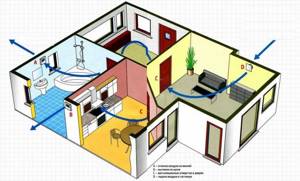
Natural ventilation - this option is the most primitive, cheap, but unreliable.
The main advantage is the affordable organization of this type of system in a private house and in a multi-story building. Of course, there are certain nuances: for example, very little air passes through the strong double-glazed windows on the windows, so the room is stuffy. If the hood is clogged, circulation is disrupted - stuffiness and mustiness appear.
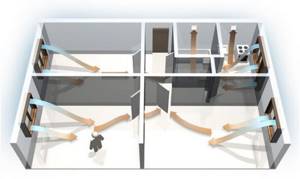
In apartments with two-way orientation, natural ventilation can work well most of the year if it is correctly designed and installed.
Forced
Forced ventilation is a special system in an apartment that ensures a constant supply of air masses inside, regardless of the weather outside. This type of ventilation allows you to completely control the inflow rate and adjust the entire equipment process to the need for air exchange. The work process does not require manual control, you do not have to open a window - it is fast and convenient for use at home.
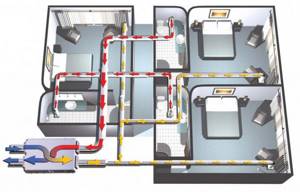
Forced ventilation in an apartment is considered the most effective.
Supply
The system consists of a heater, cooler, filters and a device for receiving and supplying air masses into the house. There are two categories: monoblock and typesetting.
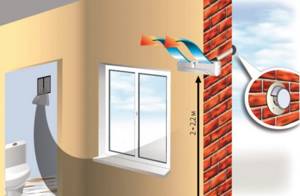
Properly organized supply ventilation in an apartment is the basis for a comfortable microclimate in a living space.
Exhaust
Using the exhaust system, exhaust air, unpleasant odors, dust, and pet hair are removed outside. To enhance natural exhaust, you can install a fan in it, having previously calculated the area of the room
This is important so as not to lose performance
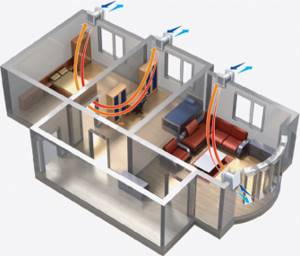
Ventilation is considered sufficient when exhaust air in each room is completely replaced with fresh air at least twice an hour.
Supply and exhaust
This type provides at the same time the influx of fresh air and the removal of exhaust air.
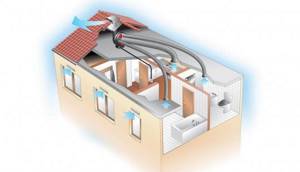
Supply and exhaust ventilation in a private house can be organized with your own hands.
Additional recovery units
There are different types of heat exchangers in the ventilation system: rotary, plate and counterflow plate. Rotary ones look like a circle, inside of which there are corrugated sheets of metal. An electric motor is installed that starts the recuperator.
Is it necessary to install a valve on windows?
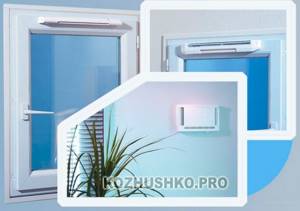
Thanks to well-organized ventilation, it becomes possible to create a comfortable microclimate in the room. It is important that clean air from the street enters the room, and polluted air with a high content of carbon dioxide is removed. In the old housing stock, oxygen entered the room through cracks in the wooden frames.
PVC profiles are completely sealed, so natural ventilation is impossible. That is why they are equipped with valves. Without them, creating and maintaining a comfortable microclimate is impossible. As a result, humidity increases, which causes black mold. The air becomes stuffy. People in the room begin to experience oxygen starvation, their performance decreases, and their well-being deteriorates.
Of course, the problem can be solved by regular ventilation. But this method has its drawbacks:
- The room becomes noisy and cold when the door is open.
- Drafts appear because air flows cannot be regulated.
- Difficulty in ventilation during precipitation and winter.
How to improve ventilation in an apartment that has plastic windows
Before you decorate your apartment with such a thing as plastic windows, make sure that the model you choose has a window ventilator.
Purchasing and installing an air recuperator, which is a kind of heat exchanger, will also help solve the problem. On average, it can serve up to 25-26 m², although this directly depends on the characteristics and properties of the device. The ideal ratio is one piece of equipment in each room. Among its main advantages are low energy consumption, quiet operation, and low cost. Also, their undoubted advantage is installation at any stage of repair, be it its beginning or completion.
Supply ventilation has a number of advantages:
- is adjusted automatically - not using the control panel, but by itself. This function is quite convenient, because you do not need to monitor the device; it itself determines when it is necessary to replace dirty air;
- change in air temperature: the equipment can both heat and cool the air. Temperature indicators depend on the source air in the apartment;
- Another advantage of mechanical ventilation over natural ventilation is that it is able to purify the air before it enters the room. So you don’t have to worry about breathing air that contains harmful substances. There are plenty of them on the street too.
Another option that will help you with fresh air in your home is a fresh air vent. As a rule, it is mounted in the window itself. Such valves can be improved with various filters and other devices, but this is not mandatory. The vent valve, like all other equipment, helps fresh air get inside. Depending on the needs of the apartment residents, its quantity can be adjusted and installed independently. How many of them need to be installed in the house? In fact, it all depends on the square footage of both the entire apartment and each individual room. For the valves to work properly, there must be an exhaust hood in the house.
In fact, there is nothing wrong with the lack of natural ventilation when installing plastic windows, because any problem can be solved. Just use any type of forced ventilation, the one that is most convenient for you. In any case, thanks to simple devices, you can breathe purified air in your apartment and not worry about your health.
Advantages and disadvantages of plastic structures

Positive aspects of plastic windows:
- The room remains warm. Sealing rubber bands, a smooth, even profile and double-glazed windows are perfectly fitted, there are no cracks or drafts, the vacuum layer between the glasses is an excellent heat insulator.
- The appearance of the frame is very neat and presentable.
- Plastic does not need constant painting, it is durable and does not dry out like wood.
This design is convenient to install; you can install a mosquito net. Compared to high-quality euro-windows made of laminated veneer lumber, for example, plastic profiles are much cheaper.
Sealing eliminates the possibility of creating a natural circulation of air masses between the room and the street. Hence the need arises for additional material costs for supply and exhaust ventilation equipment.
Plastic itself is not an environmentally friendly product and, contrary to manufacturers’ assurances, it can release harmful substances when heated.
Multi-stage “comb” ventilation mechanism
- It will ensure constant air exchange in the apartment without drafts.
- Thanks to the “comb” mechanism, condensation does not form on the windows and windowsill.
- Using a comb will provide fresh air to your apartment without overcooling it.
- The mechanism has latches, so it will never close on its own.
In ordinary PVC windows, the handle has 3 positions. Horizontally - completely open, vertically upward - open for ventilation, and the handle vertically lowered down - completely closed. With the “comb” installed, intermediate positions of the handle also appear at 60.45 and 30 degrees. In these positions, ventilation gaps of different sizes appear.
Composition of the forced ventilation system
Mechanical ventilation systems consist of supply branches and exhaust ducts. For proper operation, it is necessary that they are calculated correctly and compensate each other. Air balance must be maintained in the apartment. The inlet part may consist of the following elements:
- air supply unit and natural exhaust system (through ventilation shafts);
- supply unit and exhaust fans;
- supply and exhaust system with recuperator;
- mechanical exhaust and supply valves (wall or window).
It is more convenient to calculate and configure a system with mechanical inflow and exhaust.

Air handling unit with recuperator in the apartment.
The use of units with a recuperator allows you to reduce the cost of heating fresh air, but you need to carefully calculate the air exchange. Such a unit does not take into account the presence of separate exhaust systems from the kitchen stove and the bathroom (which cannot be combined into one network with residential premises).
Supply valves are simple and cheap devices, but they do not allow you to regulate the amount of supplied air within the required limits. Large rooms require the installation of several of these valves. It all depends on the quality and correct choice of exhaust devices.

Diagram of a system with forced exhaust ventilation in an apartment.
What does the lack of normal ventilation lead to?
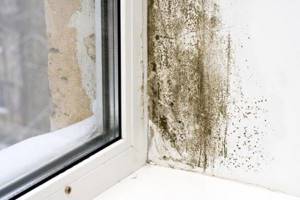
The supply and exhaust system is considered normal if it provides the standard standards for humidity and air purity in the room specified in SNiPs. This directly depends on its performance and the correct location of the supply valves. Unsuccessful ventilation arrangement or lack of ventilation capacity can lead to the following consequences:
- Increased humidity in the room. The walls become damp, streaks form on the glass, and water accumulates on the window sills.
- Blackening in the corners. Moisture promotes the formation of colonies of fungi that settle in shaded areas.
- Deterioration in health. In a poorly ventilated building, pathogenic bacteria actively accumulate. In addition, fungi release microscopic spores, which cause allergic reactions and complications to the respiratory organs.
- Damage to furniture and interior elements. Dampness promotes peeling of parts of wood boards and swelling of coatings.
- Excessive dryness in the room. The problem occurs when there is no ventilation and the radiators are very overheated. It’s hard to breathe in your home and the furniture is drying out.
Dry air is poorly tolerated by indoor plants; additional humidifiers are required.
Condensation on the surface of the window glass
From time to time, despite all the tricks aimed at reducing the level of humidity in the room, condensation still appears on the window glass. Many people use various folk remedies to combat it, wipe the windows with dry napkins and rags, and additionally ventilate the room afterward.
Only ventilation grilles for window sills will help you cope with the emerging situation once and for all. Only they will keep the window profile dry, thereby extending its service life for a long time.
Types of devices
A grill installed in the window sill more effectively distributes the flow of warm air near the window, preventing the accumulation of liquid on the glass.
There are many varieties of these devices:
- external, internal and transfer;
- unregulated, adjustable and inertial.
In addition, depending on the type of materials used, gratings are divided into:
- polymer - one of the most common materials, which over time can turn yellow and warp from exposure to high temperatures;
- aluminum - have a good light weight and appearance, the disadvantage is a high price;
- made of wood - goes well with any type of room design, but requires care and special attention;
- metal - have enormous weight, price and attractive appearance.
Installing gratings on a window sill
To independently install devices that help eliminate condensation from the surface of window glass and frame, you need to stock up on the following tools:
- drill;
- marker;
- jigsaw;
- glue for joining polymers;
- weight to secure the grille during installation.
The sequence of actions for installing the grille on the window sill is as follows:
- A pre-purchased device is applied to the window sill, which is outlined along the contour with a pencil or marker.
- Holes are made in the corners of the resulting figure using a drill. Their diameter should be slightly larger than the width of the jigsaw blade.
- After this, a part of the window sill is cut out along the drawn lines. In the future, the place of the removed part will be taken by a decorative grille, providing free access to heated air.
- Then gluing is done. Excess adhesive must be immediately removed with cotton or linen cloth. Once the glue has hardened, this will be problematic.
- Before complete polymerization, a weight must be placed on the attached ventilation grille.
Market leaders - Aereco and Air-box
The domestic valve market is 90% occupied by two manufacturers Aereco (France) and Air-box (Russia). You should have an idea about the features of their products:
High quality and practical option
Valves from Aereko are a lining that has an attractive appearance (there are color variations) that fits into any interior. The most optimal installation option is during the manufacture of PVC windows. However, if double-glazed windows are already in place, installation can also be done. This will require some minor drilling of the frames.
The device consists of 8 (16) moisture-sensitive plates. Depending on the humidity level, they can open or close the damper. Moreover, they do not require power supply to operate. The operating principle is based on the physical law of thermal expansion.
You can even mount them into the wall. This method is used mainly in wooden buildings, since it is extremely difficult to mill reinforced concrete structures. In terms of its qualities, this manufacturer looks like the best analogue on the market. However, it has an important drawback - the high price (from 2,500 thousand rubles).
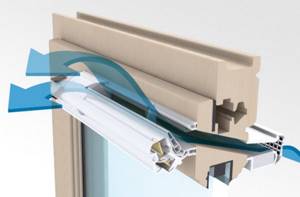
Cheaper analogue
The Russian air-box manufacturer makes its products much simpler, which at the same time almost does not lag behind in efficiency from its more expensive “brothers”. Such models allow street air to penetrate through the space between the frame and the sash. It leaks out due to the replacement of the standard seal. To control the air flow, you need to move the regulator handle.
Such models are much simpler and require manual control. At the same time, they carry two very important advantages - low cost (on average from 400 rubles) and a simpler installation method. Air-boxes are installed in two ways - by milling the frame (as with the previous manufacturer) and by replacing the seal (discussed below).

Window fittings
Metal parts will ensure the window opens in different planes
When assembling a window, metal parts are installed in a groove on the profile, which provide various opening positions and clamping of the sash in the closed position. A micro-ventilation mechanism can be included in this system. Ideally, it is installed immediately at the time of assembly at the factory.
But if the window was installed a long time ago, it is quite possible to install the mechanism on site. To do this, you should contact specialists. Any company engaged in the repair of metal-plastic structures provides this service.
The mechanism fixes the gap between the sash and the frame, sufficient for air flow (no more than 3 mm). It usually opens by turning the handle 45 degrees. There are multi-stage locking mechanisms (handle rotation by 15, 45 and 60 degrees).
Option 3 – comb / adjustable limiter
A comb is a stopper with teeth for fixing the sash. Fixes a gap from 3 to 60 mm in an inclined position. There are external and internal combs. The external option is a plank (shown in the figure below), and the internal comb is a multi-stage slot ventilation, which we already discussed above.
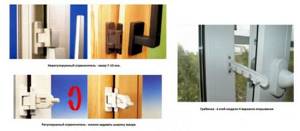
Limiters - an option for any windows

The internal comb is a multi-stage slot ventilation, built into the profile from the inside
Advantages of the comb and limiter:
There are 4-5 fixation options, you can choose a comfortable ventilation mode. External comb and stopper can be installed on any window
This is important because internal fittings for micro-ventilation cannot be installed on non-standard sizes of swing and tilt-and-turn sashes. Disadvantage: the window can be easily opened manually
If there is a small child at home who climbs onto the windowsill, then this is critical
Disadvantage: the window can be easily opened manually. If there is a small child at home who climbs onto the windowsill, then this is critical.


